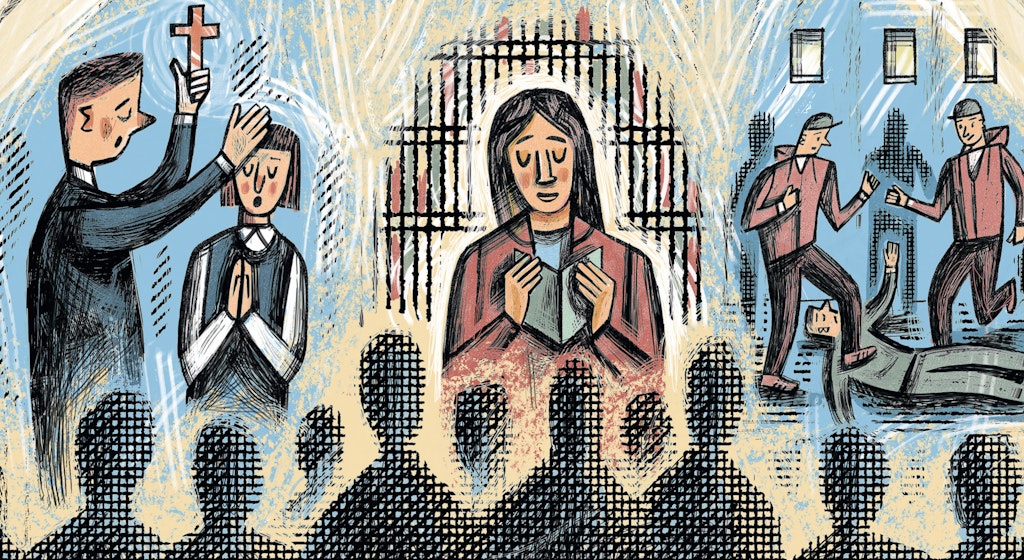Not drinking but drowning
Lisa Hilton sees Venice disappear beneath the flood waters again and fears for the future
The sirens sound six hours in advance. Three long blasts, then the haunting, eerily beautiful wail, a lament from the Adriatic plain. Silently, the water begins to rise. The smaller canals vanish first, then the vaporetto stops along the Canale Grande begin to heave and tilt, until Venice is drowning in its own reflection. Whilst the tourists wade through St Mark’s Square in hastily acquired plastic overshoes, my neighbours grimly fit their paratie, the metal gates designed to lock out the acqua alta or high tide.
Across the city, high gangways form paths between bridges under which boats can no longer pass. The official level for acqua alta is 110 cm; at 120 cm the gangways float uselessly. At 140 cm the Zattere becomes impassable, battered by shoulder-high waves. At 160, the lights go out and the helicopters start circling. At 180, the water starts to flow in.
You know the rest. You’ve seen the headlines and the Facebook videos, and forgotten them already. There’s an election on and Venice has flooded yet again, so what?
After three days, when I was finally able to leave my sodden wreck of a flat, I walked through streets filled with rotting, discarded furniture across the Accademia Bridge to Harry’s Bar. My new lodgers came with me, a young couple who are now homeless, all their possessions destroyed, their ground-floor flat uninhabitable.
The city was empty and silent. Passing the Institute of Science and Letters we saw that the building’s Renaissance lobby was still half full of water, the marble busts of Goldoni, Marco Polo and Tintoretto reclaimed by the lagoon.
Harry’s, unlike its unluckier neighbours, was open. Signor Cipriani, immaculate in his pinstriped suit, was making his round of the tables, as he has been doing each evening for much of his 89 years. I’m not a fan of Harry’s. The lights are awful, and if a clientele ever needed sympathetic illumination it’s the clientele of Harry’s.
The service manages to be at once oleaginous and dictatorial; the food is perfectly pleasant whilst being uninteresting and comically overpriced. We ate prawn risotto and some filets of sole with far too many oversalted zucchini. Dull, dry Venetian biscuits are offered whether one requests them or not.
There’s nothing to look at except the people, and like the biscuits they’ve seen better days. But that evening, as the waters subsided leaving heartbreaking damage and a furious population, it was the gesture that mattered.

This wasn’t supposed to happen. In 2003, work was begun on the Mose, a supposedly state-of-the-art barrier system designed to protect Venice against flooding. Fifteen years and eight billion euros of public funds later, the project is, in theory, 90 per cent finished, yet the technology is already outdated, the barriers in the lagoon rusted and swarming with shellfish. No attempt was made during the recent crisis to ascertain if the system was functioning.
So far, the only profit from the scheme has been to the benefit of what Venice’s newspaper, Il Gazzettino refers to as a “consortium of thieves”, the committee headed by the former head of the New Venice Consortium, Giovanni Mazzacurati. Mr Mazzacurati, who lives in exile in California, is accused of embezzling 54 million euros during his 32-year tenure.
At San Nicolò, on the Lido, the base of the Mose development, the site is padlocked and deserted, the signs proudly announcing the completion of different phases of the programme already overgrown with weeds. Vicenzo Marinese, the president of Confindustria Venezia, claimed last year that the Mose would be finished —“the time for noise on social media is over. What we need are facts.”
The fact is that the government’s latest claim that, after the city has suffered its worst acqua alta since 1966, the Mose will now be operational next year, is a lie. The promise has been confidently trumpeted throughout the international media, just like last summer’s hollow claim that cruise ships in the lagoon (a major cause of the problem) are now banned.
The Mose can’t be finished because there’s nothing to finish. The city will continue to depend on the barriers erected by the Most Serene Republic in the eighteenth century.
Signor Cipriani is one of the few Venetians whose dissent has been heard. The Mose, he says, was designed “by people who don’t know Venice and don’t understand Venice”.
Whatever incomers like me think of his grilled cheese sandwiches, he has given his life’s work to a city whose beauty forms part of the collective imagination of the world.
In Cipriani’s view, “Saving Venice” is a concept that has been appropriated by social-climbing foreigners looking to augment their cultural cachet. Venetians deserve better, and they deserve it quickly. This year’s tide was officially registered at 187 cm. If the waters reach 200cm, the city will become a new Atlantis. And the only noise to be heard at the Mose for now is that of the slowly encroaching waves.
Harry’s Bar is at Calle Vallaresso, 1323, 30124 Venezia VE, Italy.
Telephone: +39 041 528 5777
Enjoying The Critic online? It's even better in print
Try five issues of Britain’s newest magazine for £10
Subscribe














